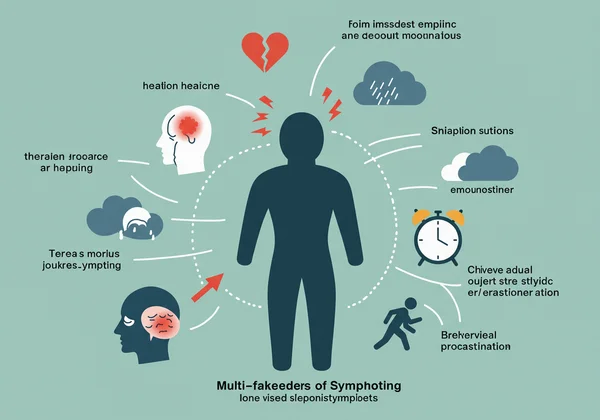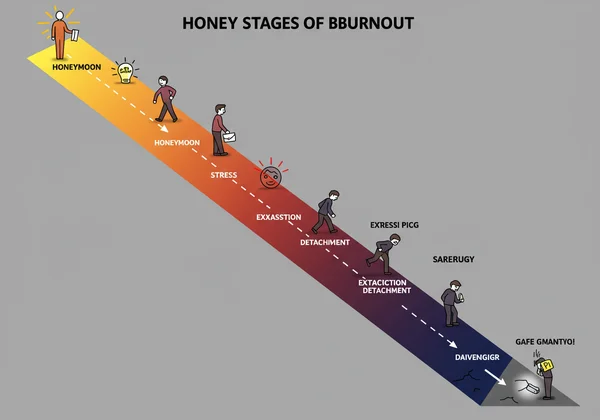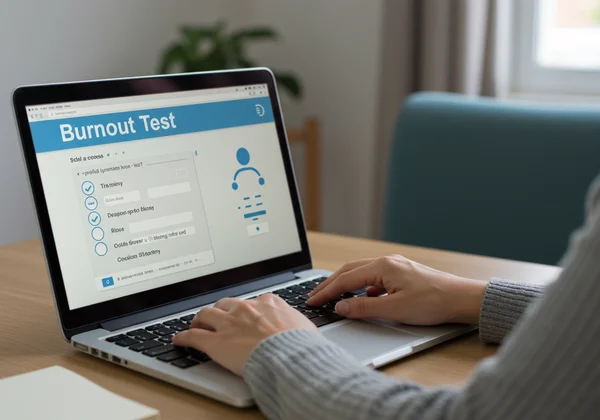Occupational Burnout Guide: Symptoms, Stages, & Test
Feeling drained, cynical about your job, and wondering if your professional spark has fizzled out? You're not alone. That persistent exhaustion is more than just tiredness; it could be occupational burnout, a serious state of emotional, physical, and mental depletion caused by prolonged workplace stress. But what are the five stages of burnout, and how can you tell if you're on this dangerous path? This comprehensive guide will help you understand the symptoms, navigate the stages, and discover how a Burnout Test can be your first step toward clarity and recovery. Ready to find answers? You can start your assessment now.
Understanding Occupational Burnout: What Is It?
Occupational burnout isn't a sign of personal failure or an inability to cope. It is a recognized syndrome resulting from chronic workplace stress that has not been successfully managed. Unlike stress, which is often characterized by over-engagement and urgency, burnout is a state of disengagement and emotional exhaustion. Understanding its core components is crucial for identification.

Beyond Fatigue: Defining Professional Burnout
To truly grasp professional burnout, we need to look beyond the surface-level feeling of being tired. Drawing from foundational psychological research like the Maslach Burnout Inventory (MBI), burnout is defined by three primary dimensions:
- Emotional Exhaustion: This is the hallmark of burnout. It's a profound sense of being emotionally overextended and drained by your work. You might feel you have nothing left to give, both to your job and to the people around you.
- Depersonalization or Cynicism: This dimension involves developing a negative, detached, or overly cynical attitude toward your job, your colleagues, and your clients. It's a psychological defense mechanism to cope with the overwhelming emotional demands of your work.
- Reduced Personal Accomplishment: This involves a decline in feelings of competence and achievement in your work. You may feel ineffective, lack a sense of purpose, and doubt the significance of your contributions, no matter what you accomplish.
Common Signs of Job Burnout: Spotting the Symptoms
The signs of burnout can manifest physically, emotionally, and behaviorally. Recognizing them is the first step in addressing the problem. A Burnout Symptoms Test often looks for patterns across these areas.

Physical Symptoms:
- Chronic fatigue and persistent exhaustion that sleep doesn't fix.
- Frequent headaches or muscle pain.
- Changes in appetite or sleep habits.
- Lowered immunity, leading to more frequent illnesses.
Emotional Symptoms:
- A sense of dread about going to work.
- Feelings of failure, self-doubt, and helplessness.
- Loss of motivation and a growing sense of detachment.
- Increased irritability and a cynical outlook on your career.
Behavioral Symptoms:
- Withdrawing from responsibilities and isolating yourself from others.
- Procrastinating and taking longer to get tasks done.
- Using unhealthy coping mechanisms like food, alcohol, or drugs.
- Skipping work or consistently coming in late and leaving early.
If these symptoms resonate with you, it might be time to check your stress levels with a structured assessment.
The Journey of Burnout: Exploring Its Stages
Burnout doesn't happen overnight. It's a gradual process that unfolds over time, often progressing through distinct stages. Understanding this journey can help you identify where you are and intervene before it becomes debilitating.
From Honeymoon to Habitual: The 5 Stages Explained
Psychologists have identified five key stages in the development of burnout:
-
The Honeymoon Stage: When you start a new job or take on a new project, you often feel high job satisfaction, commitment, and energy. However, during this phase, you might also begin to develop coping strategies that are not sustainable in the long run.
-
The Onset of Stress Stage: Reality sets in, and you become aware that some days are more difficult than others. Optimism wanes, and you may start experiencing common stress symptoms like fatigue, irritability, or difficulty concentrating.
-
The Chronic Stress Stage: The stress becomes more persistent. You might feel pressured, overworked, and increasingly unable to keep up. Motivation drops, and you may notice a decline in performance alongside feelings of anger or apathy.
-
The Burnout Stage: This is the critical stage where symptoms become severe. You feel completely exhausted and cynical, and your sense of inefficacy is pervasive. You may struggle to function and feel numb or empty.
-
The Habitual Burnout Stage: At this final stage, burnout becomes so embedded in your life that it feels normal. You may experience significant emotional, physical, or mental problems, including chronic sadness or depression.

Burnout vs. Stress vs. Laziness: Knowing the Key Differences
It’s easy to confuse these states, leading to guilt and self-blame. Let’s clarify:
- Stress is characterized by over-engagement. You feel a sense of urgency and hyperactivity, and your emotions are often heightened. You still believe you can get things under control if you just work harder.
- Burnout is characterized by disengagement. You feel empty, helpless, and devoid of motivation. Instead of urgency, you feel a deep sense of detachment and hopelessness.
- Laziness is a choice or a habit of unwillingness to exert oneself. Burnout is not a choice; it's a state of profound exhaustion where you lack the capacity to exert yourself, even if you desperately want to.
Questioning if you're just lazy is a common thought for those experiencing burnout. An objective assessment can help you find your clarity and move past self-criticism.
Assessing Your Burnout Risk: The Value of a Job Burnout Test
If you recognize yourself in the descriptions above, the next logical step is to gain a clearer understanding of your personal situation. An online burnout assessment provides an objective, data-driven starting point for self-reflection and action.
Why a Reliable Burnout Assessment Matters
Using a scientifically-backed self-assessment tool offers several key benefits. It moves you from vague feelings to concrete data, helping you understand which dimensions of burnout (exhaustion, cynicism, or inefficacy) are affecting you most. This early identification is crucial for prevention and effective intervention. A reliable test provides a confidential, private space to explore your feelings without judgment, empowering you with the knowledge needed to make informed decisions about your well-being.
Take Your Free Burnout Test Today
The best way to begin this journey is with a tool designed for clarity and action. Through our online platform, you can take our free test right now. Our assessment is based on established psychological principles like the MBI to provide you with a reliable snapshot of your burnout risk.

The process is simple, anonymous, and requires no registration. After answering a series of research-backed questions, you'll receive an instant summary of your results. For those seeking deeper understanding, you have the option to unlock a personalized, AI-driven report that offers actionable insights into your strengths, challenges, and a tailored action plan. It's time to stop guessing and get instant results.
Disclaimer: This test is an educational screening tool and not a substitute for a professional medical diagnosis. If you are experiencing severe symptoms, please consult a qualified healthcare professional.
Preventing & Recovering From Workplace Burnout
Identifying your risk is the first step. The next is taking action to prevent burnout or begin the recovery process. The goal is to build resilience and create a more sustainable work-life balance.
Proactive Strategies for Prevention and Well-being
Preventing burnout is about building healthy habits and boundaries before stress becomes chronic.
- Set Clear Boundaries: Learn to say "no." Define your work hours and stick to them. Disconnect from work-related communications during your personal time.
- Prioritize Self-Care: Make time for activities that recharge you, whether it's exercise, hobbies, or spending time with loved ones.
- Practice Mindfulness and Stress Management: Techniques like meditation, deep breathing, and journaling can help manage daily stress before it accumulates.
- Seek Social Support: Connect with trusted colleagues, friends, or family members to share your feelings and gain perspective.
Pathways to Recovery: Practical Steps for Healing
If you're already experiencing burnout, burnout recovery is possible. The journey often involves the "Three R's":
- Recognize: Acknowledge the signs of burnout in yourself without judgment. Taking a Job Burnout Test is a powerful way to do this.
- Reverse: Actively work to undo the damage by seeking support, reducing your workload if possible, and taking time off to rest and disconnect.
- Resilience: Build your strength against stress by focusing on your physical and emotional health, setting boundaries, and re-evaluating your goals and priorities.
Your path to healing is unique. The first step is to start your recovery journey with self-awareness.
Taking Control: Your Path to Well-being Beyond Burnout
Occupational burnout is a serious and draining condition, but it is not a life sentence. By understanding its definition, recognizing its symptoms, and identifying its stages, you can reclaim your power. Knowledge is the first tool, but action is what creates change. Self-assessment provides the crucial bridge between the two.
Don't let exhaustion and cynicism define your professional life any longer. You have the ability to understand your situation and take meaningful steps toward a healthier, more fulfilling career. The journey starts with a single, simple action. Take control today by discovering your burnout risk with our free, confidential test.
Frequently Asked Questions About Occupational Burnout
What are the five stages of burnout?
The five commonly recognized stages of burnout are: 1) The Honeymoon stage, with high initial job satisfaction; 2) The Onset of Stress, where awareness of difficult days grows; 3) Chronic Stress, where stress becomes persistent; 4) The Burnout stage, where symptoms become critical; and 5) Habitual Burnout, where burnout is deeply embedded in your life.
What does burnout fatigue feel like?
Burnout fatigue is a profound exhaustion that isn't relieved by rest or sleep. It feels like a complete depletion of your physical and emotional energy, making even small tasks feel monumental. It's often accompanied by a sense of dread and a lack of motivation.
Is it burnout or am I just lazy?
Laziness is an unwillingness to act, whereas burnout is an inability to act due to severe emotional and physical exhaustion. If you want to be productive but find you lack the mental and physical capacity to do so, you are likely experiencing burnout, not laziness.
How do you test for burnout?
You can test for burnout using self-assessment questionnaires designed to measure its core dimensions. These tests, often based on scientific models like the Maslach Burnout Inventory, ask about your feelings related to emotional exhaustion, cynicism, and professional efficacy. A confidential online burnout assessment is a great place to start.
How to recover properly from burnout?
Proper recovery involves the "Three R's": Recognize the problem, Reverse the damage by prioritizing rest and seeking support, and build Resilience through healthier habits and boundaries. It often requires re-evaluating your relationship with work and making intentional changes to support your long-term well-being.